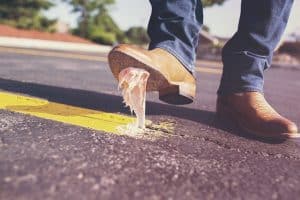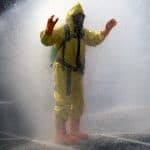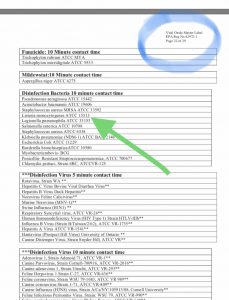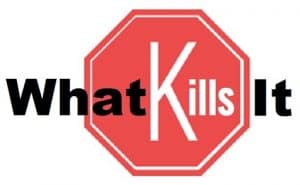Listeria Monocytogenes is a highly dangerous, microscopic bacteria pest that infiltrates our food supply and it also develops on food, over time, during refrigeration. One out of every five people die from complications of Listeriosis and the heartbreaking statistic is that pregnant women, unborn fetuses and infected newborns, make up a generous portion of a staggering 20% death rate.
Even if we are lucky enough to catch a recall before eating the contaminated food, it is highly likely that, in the process of storing and handling the suspect food, we may have (inadvertently) contaminated our sinks, kitchen counters or crisper drawers.
So what kills listeria on surfaces? Home remedies will not work on this resilient, deadly bacteria. To kill Listeria Monocytogenes on household surfaces, use an EPA registered disinfectant proven to kill Listeria or Gram-Positive bacteria. Then, it is critical that you thoroughly rinse – Here’s Why…
Listeria Monocytogenes rather enjoy colder temps and find our refrigerators to be a perfect environment to live, breed and multiply. They are also quite adept at attaching to smooth surfaces via sticky fibers that can be characterized as an adhesive undergrowth.
Why Rinse a No-Rinse Disinfectant when Trying to Get Rid of Listeria?
Unlike other bacteria which is rather easy to kill and wipe away, Listeria grows an underbelly consisting of sticky attachment fibers. A worthy analogy would be: like bubblegum to a shoe.

Depending on the level of contamination, Listeria’s unique fibers could be strong enough to allow the miniscule surviving listeria to enjoy a rebirth.
Remember, no disinfectant can guarantee a 100% removal of pathogens. which means some cells could be left behind. That is why labels will say “Kills 99.9% of germs.” Believe us, if a company could say 100%, they would!
Additionally, studies have shown that rinsing Listeria Monocytogenes contaminated surfaces after disinfection helps remove miniscule, residual surviving cells that may be capable of making a rebound.
Coming up, we’re going to rank 3 popular disinfectants you can use to kill Listeria Monocytogenes on surfaces and show you which one rises to the top in our humble opinion.
First: Why Choose a No-Rinse Disinfectant to Kill Listeria on Surfaces?
If there’s anything good to say about Listeria, I suppose that would be that it’s typically limited to kitchens or restaurants where raw food is stored and prepped. That’s not to say it can’t be anywhere in your home (especially homes of raw food handlers) but the most common place of contamination is our kitchens.
And since most of us will be dealing with Listeria bacteria in our kitchens, we’ll make our lives easier when we choose a disinfectant that is safe to use on food contact surfaces that doesn’t require a complete rinse down after disinfection. Most disinfectants are NOT rated for food surfaces and that is why we would us a food-surface-friendly product.
Even though our top pick for disinfecting Listeria on surfaces is a no-rinse formula, we say….no; we shout: You Must Rinse it Anyway!
Let’s get into the studies!
Ranking Results of Disinfectant Active Ingredients that Can Be Used to Kill Listeria on Surfaces
In a 2018 head to head disinfectant study, 4 popular disinfectants were analyzed for their ability to kill Listeria Monocytogenes. Although all four were capable of killing listeria, there were measurable performance factors. Here was the final outcome of the disinfectant testing:
- 1st Place-Peroxyacetic Acid
- 2nd Place-Chlorine Dioxide
- 3rd Place -Quaternary Ammonium
- 4th Place-Chlorine Bleach
Let’s talk about these disinfectants.
Peroxyacetic Acid – Now peroxyacetic acid performed the best, but it’s NOT available for household use. This is strong, industrial strength, suit-up, hose-down type of product. Here is a snippet from it’s safety data sheet:

Peroxyacetic Acid – PERSONAL PROTECTIVE EQUIPMENT Handlers who may be exposed to the undiluted product through mixing, loading, application, or other tasks must wear: coveralls over long-sleeved shirt and long pants, rubber gloves, chemical resistant footwear plus socks, and protective eyewear (goggles or face shield). Handlers who may be exposed to the undiluted product through application or other tasks must wear: long-sleeved shirt and long pants, and shoes plus socks.
No way is the average household looking for something like Peroxyacetic Acid. With that option out of the way, we are left with 3 viable options for killing listeria on household surfaces and they are found in these products as follows:
Our Top Pick for Killing Listeria on Surfaces
Not only did Chlorine Dioxide come in second place in testing, we like it because it’s about as environmentally friendly as a disinfectant can be. It’s an official hospital disinfectant and chlorine dioxide is often use to treat drinking water.
1-2% Chlorine Dioxide solutions are easy on the hands and the lungs during the disinfection process. Where to find Chlorine Dioxide?
We get it shipped from online marketplaces like amazon. Two well known products that contain the Chlorine Dioxide are Vital Oxide and Sniper. (links to product pricing)
#1 PICK – Chlorine Dioxide is in- Vital Oxide – Epa Reg.# 82972-1
Our top pick is Vital Oxide because Listeria Monocytogenes is specifically listed on it’s kill list which can be found online at the EPA website. Here is a clickable image of Vital Oxide and you can click it to see current pricing and availability.

click image to pricing
Here is a photo/snapshot of Vital Oxide’s 34 page EPA filling.

#2 Pick: Chlorine Dioxide is in Sniper Hospital Disinfectant Epa Reg. # 71700
click image to pricing

Sniper doesn’t specifically list Listeria on it’s kill list. That is not uncommon for a disinfectant to use generalizations such as: “kill gram-negative bacteria” or “kills gram-positive bacteria.”
Listeria is a Gram-Positive Bacteria and Sniper claims to kill Gram-Positive bacteria. Personally, we prefer to see the name of the bacteria listed, and that’s why Vital Oxide is our top pick. But that’s us…
Where Else Can You Find Chlorine Dioxide that Kills Listeria?
It’s not often found in retail stores but some Home Improvement Centers like Home Depot might have it during certain seasons. You can check your local center by clicking the image and entering Vital Oxide or Sniper in the search bar.
Other Notable Disinfectants for Killing Listeria on Surfaces
Quaternary Ammonium – Most quaternary ammonium products (QAC’s) will kill Listeria. One we can think of is: Clorox Broad Spectrum Quaternary Disinfectant Cleaner. In addition to the disinfectant, buy yourself gloves and respiratory protection.
Most QAC’s are NOT rated for kitchen use so beware this should be for places like garbage cans, and other non-food areas.
Worried about Listeria ON food? Check our article here,
In studies, QAC Beat Sodium Hypochlorite (Bleach) in all categories.
Sodium Hypochlorite (Bleach) – Clorox Clean-Up – Epa Reg. 5813-21
Clorox Clean-up can be found in just about any full service grocery related store. So Bleach kills Listeria on surfaces? Yes it does, but studies show (link to study) that all other products outperformed bleach in 3 categories
- Quantity Needed
- Time Required
- Surface Type (Pitted vs Smooth)
Bleach is also caustic to the respiratory system. If you want to go the bleach route, be sure to use PPE (personal protective equipment) and remove people and animals from home. Dilute it exactly as instructed on the bottle and follow directions described.
TIP: Never buy cheap “bleach” that doesn’t have the words “KILLS GERMS” on the label. These are either too diluted to disinfect or a different recipe all together. You will NOT kill listeria with these versions of bleach.
Conclusion
Listeria is unique. It grows over time in cool conditions and makes your refrigerator an ideal breeding ground. It also grows an adhesive underbelly which can survive any lame, half-hearted attempts of removal.
If you’re dealing with listeria contamination in your kitchen area here are some tips:
- Go slow
- Buy a disinfectant rated for killing listeria
- Disinfect every suspect object
- Responsibly wrap and throw away suspected contaminated food
- Rinse after disinfecting
Our top choice of disinfectant ingredient is: Chlorine Dioxide. That’s because it is the least harsh and does the job. Whichever disinfectant you choose, rinse, rinse, rinse.
Here are Vital Oxide and Sniper links one last time.
Rinsing After Disinfecting Listeria
… the method used in this study assumed inadequate post-rinsing of the cell-sanitizer mixtures (plating was done immediately after neutralization of the sanitizers without rinsing the SS first). This.indicates that proper cleaning, disinfection, and post-rinsing are all important in eliminating microorganisms. Inadequate pre-cleaning can leave behind soil residues that may not be visible by the naked eye and can lower the effectiveness of sanitizers used. A low level of surviving cells present on equipment surfaces after the sanitation step can then easily grow and multiply in the presence of these organic materials which can provide nutrients for the cells especially if subsequent postrinsing is inadequate (23,24,26).
Link to Study
